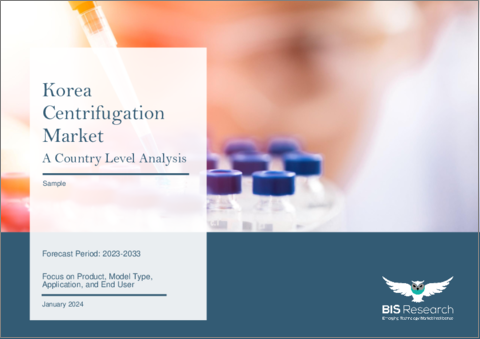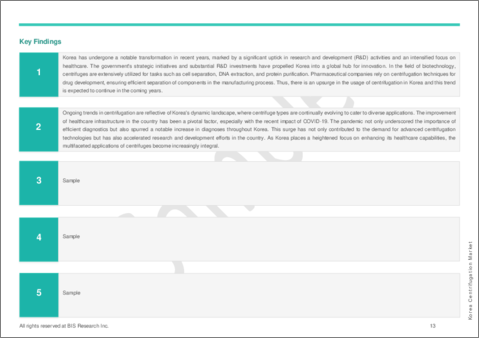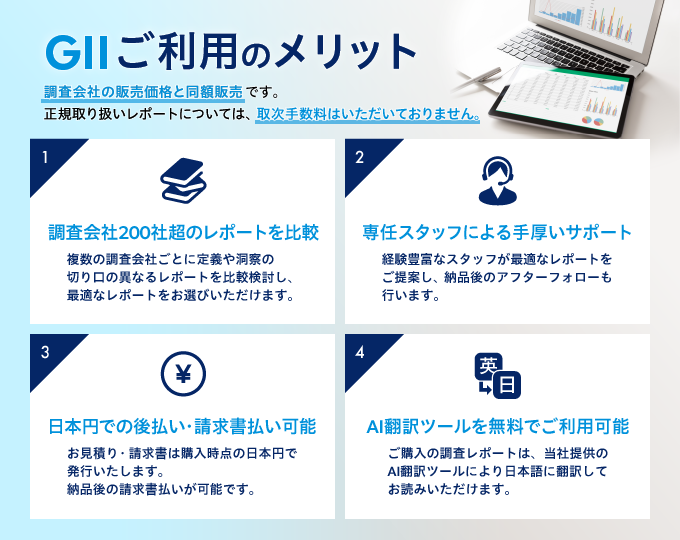|
|
市場調査レポート
商品コード
1419697
韓国の遠心分離機市場:国別分析:モデルタイプ別、用途別、エンドユーザー別 - 予測(2023年~2033年)Korea Centrifugation Market - A Country Level Analysis: Focus on Product, Model Type, Application, and End User - Forecast Period, 2023-2033 |
||||||
カスタマイズ可能
|
|||||||
| 韓国の遠心分離機市場:国別分析:モデルタイプ別、用途別、エンドユーザー別 - 予測(2023年~2033年) |
|
出版日: 2024年02月02日
発行: BIS Research
ページ情報: 英文 73 Pages
納期: 1~5営業日
|
全表示
- 概要
- 図表
- 目次
韓国の遠心分離機の市場規模は2023年に4,610万米ドル、2033年には8,060万米ドルに達するとみられ、2023年から2033年にかけてCAGR 5.75%で成長すると予測されています。
遠心分離機は、流体、気体、液体を密度に応じて分離するように設計された科学機器です。この分離は、物質を入れた容器を急速に回転させることによって達成されます。遠心分離機は、粒径、形状、密度、粘度に基づいて溶液から粒子を分離するために不可欠な実験器具として機能します。この分離の効率はローターの回転速度に依存します。現代のビジネスおよび科学環境において、実験室用遠心分離機は広く採用されているツールです。特に化学、生化学、分子生物学の研究室など、多様な研究室環境で広く使用されています。
| 主要市場統計 | |
|---|---|
| 予測期間 | 2023年~2033年 |
| 2023年評価 | 4,610万米ドル |
| 2033年予測 | 8,060万米ドル |
| CAGR | 5.75% |
当レポートでは、韓国の遠心分離機市場について調査し、市場の概要とともに、モデルタイプ別、用途別、エンドユーザー別、地域別の動向、および市場に参入する企業のプロファイルなどを提供しています。
目次
エグゼクティブサマリー
範囲と定義
第1章 市場
- 規制状況
- 動向:現在および将来の影響評価
- 韓国の遠心分離機市場に対するCOVID-19の影響
- 市場力学の概要
第2章 韓国の遠心分離機市場、製品別
- 市場概要
- 製品のセグメンテーション
- 装置
- アクセサリ
第3章 韓国の遠心分離機市場、モデルタイプ別
- 市場概要
- アナリストビュー
- 成長シェアマトリックス
- モデルタイプのセグメンテーション
- ベンチトップ型
- 床置き型
第4章 韓国の遠心分離機市場、用途別
- 市場概要
- アナリストビュー
- 成長シェアマトリックス
- 用途のセグメンテーション
- 臨床
- 研究
- バイオ医薬品の製造
- その他
第5章 韓国の遠心分離機市場、エンドユーザー別
- 市場概要
- アナリストビュー
- 成長シェアマトリックス
- エンドユーザーのセグメンテーション
- 病院と血液バンク
- バイオテクノロジー企業と製薬会社
- 学術研究機関
- その他
第6章 市場-競合ベンチマーキングと企業プロファイル
- Agilent Technologies, Inc.
- QIAGEN N.V.
- Bio-Rad Laboratories, Inc.
- Thermo Fisher Scientific, Inc.
- Danaher Corporation (Beckman Coulter, Inc.)
- Eppendorf SE
- Corning Incorporated
- Hanil Scientific Inc.
- Daihan Scientific Co., Ltd.
- DLAB Scientific Co., Ltd.
第7章 調査手法
List of Figures
- Figure 1: Korea Centrifugation Market, Realistic, Optimistic, and Pessimistic (2023, 2026, and 2033)
- Figure 2: Korea Centrifugation Market (by Product), $Million, 2022, 2026, and 2033
- Figure 3: Korea Centrifugation Market (by Model Type), $Million, 2022, 2026, and 2033
- Figure 4: Korea Centrifugation Market (by Application), $Million, 2022, 2026, and 2033
- Figure 5: Korea Centrifugation Market (by End User), $Million, 2022, 2026, and 2033
- Figure 6: Types of Centrifuges with their Range and Laboratory Uses
- Figure 7: Korea Gross Domestic Product Expenditure on Healthcare, Per Capita ($)
- Figure 8: Total COVID-19 Cases in Korea, January 2020-June 2023
- Figure 9: Impact Analysis of Market Navigating Factors
- Figure 10: Total R&D Expenditure in Korea (by Year), 2010-2020
- Figure 11: Disease Burden in Korea (by Cause), 2010-2019
- Figure 12: Korea Medical Devices Market, 2018-2021
- Figure 13: Maintaining the Centrifugation Equipment
- Figure 14: Examples of Artificial Intelligence Development in Korea
- Figure 15: Korea Centrifugation Market, Growth-Share Matrix (by Product)
- Figure 16: Korea Centrifugation Market. Growth-Share Matrix (by Model Type)
- Figure 17: Korea Centrifugation Market, Growth-Share Matrix (by Application)
- Figure 18: Korea Centrifugation Market, Growth-Share Matrix (by End User)
- Figure 19: Number of Strategic Initiatives, January 2020- November 2023
- Figure 20: Share of Strategic Initiatives, January 2020-November 2023
- Figure 21: Data Triangulation
- Figure 22: Top-Down and Bottom-Up Approach
- Figure 23: Assumptions and Limitations
List of Tables
- Table 1: Korea Centrifugation Market Snapshot, $Million, 2023 and 2033
- Table 2: Laboratory Equipment Regulatory Bodies in Korea
- Table 3: Korea Centrifugation Market, Trends and Future Impacts
- Table 4: Some of the Product Launches in Centrifugation Market
- Table 5: Korea Centrifugation Market (by Product), $Million, 2022-2033
- Table 6: Korea Centrifugation Market (by Equipment), $Million, 2022-2033
- Table 7: Korea Centrifugation Market (by Model Type), $Million, 2022-2033
- Table 8: Korea Centrifugation Market (by Application), $Million, 2022-2033
- Table 9: Korea Centrifugation Market (by End User), $Million, 2022-2033
“The Korea Centrifugation Market Expected to Reach $80.6 Million by 2033.”
Introduction of Korea Centrifugation Market
The Korea centrifugation market was valued at $46.1 million in 2023 and is expected to reach $80.6 million by 2033, growing at a CAGR of 5.75% between 2023 and 2033. A centrifuge is a scientific instrument designed to separate fluids, gases, or liquids according to their density. This separation is achieved by rapidly rotating a container containing the material. Centrifuges serve as vital laboratory apparatus for isolating particles from a solution based on their size, shape, density, and viscosity. The efficiency of this separation relies on the rotational speed of the rotor. In contemporary business and scientific settings, laboratory centrifuges are extensively employed tools. They find widespread application in diverse laboratory environments, notably in chemistry, biochemistry, and molecular biology labs.
| KEY MARKET STATISTICS | |
|---|---|
| Forecast Period | 2023 - 2033 |
| 2023 Evaluation | $46.1 Million |
| 2033 Forecast | $80.6 Million |
| CAGR | 5.75% |
Market Introduction
As per BIS Research, the Korea centrifugation market includes centrifugation equipment and accessories. Equipment can be of various types, including multipurpose centrifuges, microcentrifuges, ultracentrifuges, and others. The centrifuges can either be floor-standing centrifuges or benchtop centrifuges, depending on the model types and application. The most common applications of centrifuges include clinical, research, biotherapeutic manufacturing, and others. The end users of the Korea centrifugation market are hospitals and blood banks, biotechnology and pharmaceutical companies, academic and research institutes, and others.
Market Segmentation:
Segmentation 1: by Product
- Equipment
- Multipurpose Centrifuges
- Microcentrifuges
- Ultracentrifuges
- Others
- Accessories
Equipment Segment to Dominate as the Leading Product
Based on product, the Korea centrifugation market was led by the equipment segment, with a 72.65% share in 2022. Centrifuges serve as vital laboratory apparatus for isolating particles from a solution based on their size, shape, density, and viscosity. The efficiency of this separation relies on the rotational speed of the rotor. In contemporary business and scientific settings, laboratory centrifuges are extensively employed tools. They find widespread application in diverse laboratory environments, notably in chemistry, biochemistry, and molecular biology labs.
Segmentation 2: by Model Type
- Benchtop Centrifuges
- Floor-Standing Centrifuges
Floor-Standing Centrifuges to Witness the Highest Growth between 2023 and 2033
Floor-standing centrifuges are tailored for standard laboratory procedures, offering the benefit of optimizing benchtop space across diverse environments. This classification includes low and superspeed centrifuges, ultracentrifuges, and general-purpose centrifuges, along with replacement parts and accessories. Floor-standing centrifuges are purpose-built for the centrifugation of large volumes or achieving extremely high speeds of centrifugation. Engineered to accommodate substantial sample containers, these centrifuges are well-suited for routine clinical diagnostics, clinical laboratories, blood banks, and pharmaceutical laboratories in the business context.
Segmentation 3: by Application
- Clinical
- Research
- Biotherapeutic Manufacturing
- Others
Research to Witness the Highest Growth between 2023 and 2033
Based on application, the Korea centrifugation market was led by research, with a 42% share in 2022. Centrifugation plays a crucial role in the field of life sciences, particularly in biological research. This technique involves the use of centrifugal force to separate particles or components of a sample based on their density, size, and shape. Various types of centrifuges and techniques are employed in life sciences for a wide range of research applications.
Recent Developments in the Korea Centrifugation Market
- In April 2023, Eppendorf, a prominent life science company, unveiled the Centrifuge 5427 R, marking the introduction of Eppendorf's inaugural microcentrifuge equipped with hydrocarbon cooling. This innovation contributes to fostering a more sustainable laboratory environment. Through this advancement, users had the capability to conduct a diverse range of molecular and cell biology applications using a refrigerated device that incorporated a natural cooling agent boasting a nearly zero Global Warming Potential (GWP). The primary goal was to safeguard both samples and the planet.
- In February 2022, Beckman Coulter Life Sciences introduced its most versatile 3-liter benchtop centrifuge to date, the Allegra V-15R refrigerated centrifuge. It featured 10 rotor configurations and 50 programmable runs, along with a comprehensive array of adapters, allowing for a wide range of workflows and applications. These capabilities extended from cell and blood separation to high-throughput screening.
- In March 2020, Eppendorf AG and Koki Holdings Co., Ltd., reached an agreement in which Eppendorf acquired Koki's centrifuge business, encompassing the premium himac brand. A formal agreement was signed by both companies in Tokyo. This acquisition strategically expanded the centrifuge business of Hamburg-based Eppendorf AG, reinforcing its strong market standing as a leading global manufacturer of high-end centrifuges for the pharmaceutical and life science sectors, along with academic and commercial research.
Demand - Drivers, Challenges, and Opportunities
Market Demand Drivers:
Increasing Diagnosis of Diseases: In the last century, diagnostic testing has evolved into an indispensable aspect of routine medical procedures. The process of diagnostic testing often involves multiple iterations of gathering, integrating, and interpreting information, with each round refining the working diagnosis. Centrifugation plays a crucial role in various biological research fields, with significant applications in virology and diagnosis.
Increasing Research and Development (R&D) Expenditure in Korea: The Korean biotech industry has experienced remarkable growth, with numerous Korean biotechnology firms now holding prominent positions globally. It has emerged as a major industry in Korea, showing significant expansion. Centrifuges are one of the most important and most used instruments in a biotechnology laboratory. Thus, the increasing funding of biotechnology in Korea is ultimately leading to an increase in the usage of centrifuges and, in turn, a growth in the Korean centrifugation market.
Market Challenges:
High Competition and Market Saturation: The Korean medical devices sector has doubled in size between 2010 and 2018, according to the Ministry of Food and Drug Safety. The Korean medical devices market ranked ninth in the globe in 2018, and its revenue from imports from the U.S. increased from $0.9 billion in 2010 to $1.8 billion in 2018. There are already many manufacturers in the centrifugation market, and lately, due to the growing Korean medical devices industry, the number of players providing centrifuges has been increasing.
High Maintenance Cost of Centrifuges: Effective condition monitoring through maintenance is crucial for centrifugal pumps in various industrial processes. The increasing demand for sophisticated products with intricate specifications within strict timelines has amplified the need for enhanced machine lifespans, making it a priority for industry and production organizations. Continuous usage of centrifuges, especially in demanding industrial environments, leads to wear and tear on critical components. The frequent rotation and high-speed operation contribute to the degradation of parts, necessitating regular inspections, replacements, and adjustments, which can incur substantial maintenance costs.
Market Opportunities:
Integration of Artificial Intelligence (AI) with Centrifugation Processes: Korea is intensifying efforts to enhance AI development in the field of life sciences. The nation is strategically implementing initiatives with a primary focus on robust regulations. In a bid to propel advancements in AI, Korea is actively revising regulations within the AI domain. Korea is making significant investments in artificial intelligence, positioning itself as one of the few countries prioritizing AI in the healthcare sector. The application of artificial intelligence to centrifugal pumps is already underway, streamlining processes and generating automated alerts for maintenance and updates.
How can this report add value to an organization?
Product/Innovation Strategy: The Korea centrifugation market has been segmented on the basis of various categories, such as product, model type, application, and end user. The product segment has been further sub-segmented into equipment and accessories. Equipment is further sub-segmented into multipurpose centrifuges, microcentrifuges, ultracentrifuges, and others.
Growth/Marketing Strategy: Product launches accounted for the maximum number of key developments, and nearly 90% of the total developments in the Korea centrifugation market were between January 2021 and December 2023.
Competitive Strategy: The Korea centrifugation market is a highly fragmented market, with many smaller and private companies constantly entering the market. Key players in the Korea centrifugation market analyzed and profiled in the study involve established players that offer various kinds of instruments and accessories.
Methodology
Key Considerations and Assumptions in Market Engineering and Validation
- The base year considered for the calculation of the market size is 2022. A historical year analysis has been done for the period FY2019-FY2021. The market size has been estimated for FY2022 and projected for the period FY2023-FY2033.
- The scope of this report has been carefully derived based on interactions with experts in different companies across the world. This report provides a market study of Korea centrifugation.
- The market contribution of the Korea centrifugation anticipated to be launched in the future has been calculated based on the historical analysis of the solutions.
- Revenues of the companies have been referenced from their annual reports for FY2021 and FY2022. For private companies, revenues have been estimated based on factors such as inputs obtained from primary research, funding history, market collaborations, and operational history.
- The market has been mapped based on the available Korea centrifugation solutions. All the key companies with significant offerings in this field have been considered and profiled in this report.
Primary Research:
The primary sources involve industry experts in Korea centrifugation market, including the market players offering centrifugation equipment and accessories. Resources such as hospitals/clinics, insurance companies, distributors, senior management of major companies, and R&D specialists have been interviewed to obtain and verify both qualitative and quantitative aspects of this research study.
The key data points taken from the primary sources include:
- validation and triangulation of all the numbers and graphs
- validation of the report's segmentation and key qualitative findings
- understanding the competitive landscape and business model
- current and proposed production values of a product by market players
- validation of the numbers of the different segments of the market in focus
- percentage split of individual markets for regional analysis
Secondary Research
Open Sources
- Centrifuge equipment manufacturers and equipment suppliers, hospitals, and academic and research institutions, among others
- Annual reports, SEC filings, and investor presentations of the leading market players
- Company websites and detailed study of their portfolios
- Gold standard magazines, journals, whitepapers, press releases, and news articles
- Databases
The key data points taken from the secondary sources include:
- segmentation and percentage share estimates
- company and country understanding, and data for market value estimation
- key industry/market trends
- developments among top players
- qualitative insights into various aspects of the market, key trends, and market dynamics
- quantitative data for mathematical and statistical calculations
Key Market Players and Competition Synopsis
The companies that are profiled have been selected based on inputs gathered from primary experts and analyzing company coverage, product portfolio, and market penetration.
The equipment segment players leading the market captured around 72.65% of the presence in the market as of 2022. The accessories segment accounted for approximately 27.35% of the market presence in 2022.
Some of the prominent companies in this market are:
|
|
Table of Contents
Executive Summary
Scope and Definition
1. Markets
- 1.1. Regulatory Landscape
- 1.2. Trends: Current and Future Impact Assessment
- 1.2.1. Korea Centrifugation Market Trend Analysis
- 1.2.2. Trend 1-Wide Variety of Centrifuge Types
- 1.2.3. Trend 2-Betterment of Healthcare Infrastructure and Laboratories
- 1.3. Impact of COVID-19 on Korea Centrifugation Market
- 1.4. Market Dynamics Overview
- 1.4.1. Market Drivers
- 1.4.1.1. Driver 1-Upsurge in Healthcare Research and Development Expenditure In turn Increasing the Usage of Centrifuges
- 1.4.1.2. Driver 2-Increasing Diagnosis of Diseases Leading to Increased Usage of Centrifugation Devices for Diagnosis and Drug Development
- 1.4.1.3. Driver 3-Adoption of the Latest Technological Advancements in Centrifuges
- 1.4.2. Market Challenges
- 1.4.2.1. Challenge 1-Large Local Production of Centrifuges Leading to Surpass Usage in the Country
- 1.4.2.2. Challenge 2-Long Lifespan of Centrifuges Leading to Low Purchase Rate of the Equipment
- 1.4.3. Market Opportunities
- 1.4.3.1. Opportunity 1-Integration of Artificial Intelligence with Centrifugation Processes
- 1.4.1. Market Drivers
2. Korea Centrifugation Market by Product
- 2.1. Market Overview
- 2.1.1. Analyst View
- 2.1.2. Growth-Share Matrix
- 2.2. Product Segmentation
- 2.2.1. Equipment
- 2.2.1.1. Multipurpose Centrifuges
- 2.2.1.2. Microcentrifuges
- 2.2.1.3. Ultracentrifuges
- 2.2.1.4. Others
- 2.2.2. Accessories
- 2.2.1. Equipment
3. Korea Centrifugation Market by Model Type
- 3.1. Market Overview
- 3.1.1. Analyst View
- 3.1.2. Growth-Share Matrix
- 3.2. Model Type Segmentation
- 3.2.1. Benchtop Centrifuges
- 3.2.2. Floor-Standing Centrifuges
4. Korea Centrifugation Market by Application
- 4.2. Market Overview
- 4.2.1. Analyst View
- 4.2.2. Growth-Share Matrix
- 4.3. Application Segmentation
- 4.3.1. Clinical
- 4.3.2. Research
- 4.3.3. Biotherapeutic Manufacturing
- 4.3.4. Others
5. Korea Centrifugation Market by End User
- 5.2. Market Overview
- 5.2.1. Analyst View
- 5.2.2. Growth-Share Matrix
- 5.3. End User Segmentation
- 5.3.1. Hospitals and Blood Banks
- 5.3.2. Biotechnology and Pharmaceutical Companies
- 5.3.3. Academic and Research Institutes
- 5.3.4. Others
6. Markets-Competitive Benchmarking & Company Profiles
- 6.1. Agilent Technologies, Inc.
- 6.2. QIAGEN N.V.
- 6.3. Bio-Rad Laboratories, Inc.
- 6.4. Thermo Fisher Scientific, Inc.
- 6.5. Danaher Corporation (Beckman Coulter, Inc.)
- 6.6. Eppendorf SE
- 6.7. Corning Incorporated
- 6.8. Hanil Scientific Inc.
- 6.9. Daihan Scientific Co., Ltd.
- 6.1. DLAB Scientific Co., Ltd.
7. Research Methodology
- 7.1. Data Sources
- 7.1.1. Primary Data Sources
- 7.1.2. Secondary Data Sources
- 7.1.3. Data Triangulation
- 7.2. Market Estimation and Forecast





